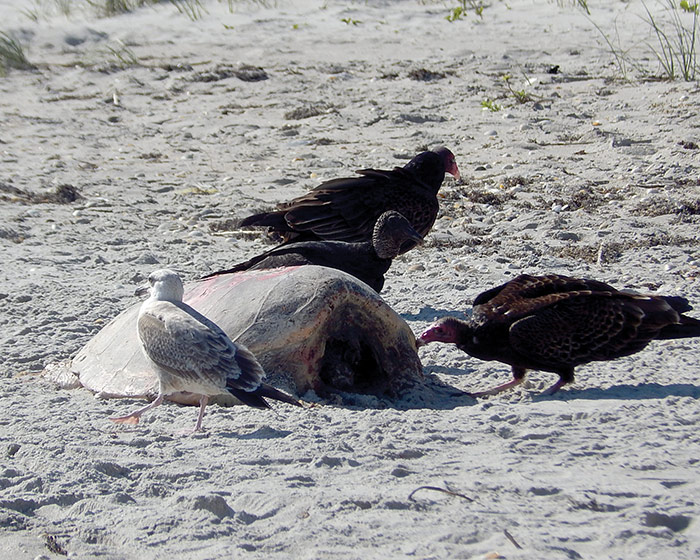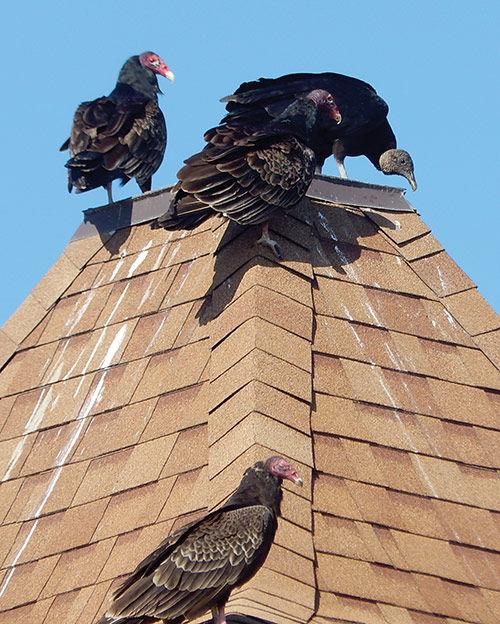Turkey Vultures: An Asset to an IPM Approach and "Nature's Roadkill Clean-Up Crew"
 |
|
Black vultures inspecting a sea turtle carcass on a Florida beach. Photo: M. Anderson, U.S. EPA |
By Marcia Anderson, PhD, U.S. EPA
Turkey vultures can often be seen along roadsides feeding on roadkill, near bodies of water feeding on washed-up fish or turtles, or even at landfills picking through waste.
They do not kill live animals, as they have little to no hunting ability due to their dull and weak talons. However, they make up for that with their superior sense of smell, which can detect dead animals from miles away. They feed almost exclusively on carrion, playing an important role in the ecosystem by disposing of dead animals, which reduces the spread of disease.
The vultures prefer freshly deceased animals but will often wait for their meal to soften through some decomposition to facilitate piercing the carcass skin. They avoid carcasses that have reached the point of putrefaction.
Nature’s Recyclers and Sanitizers
While vultures don’t share the conventional good looks of eagles or osprey, the ecosystem services they provide are irreplaceable. They compete with—and control—populations of rats, feral dogs, blowflies, and other scavengers, many of which are disease vectors. They ultimately make the world cleaner and healthier.
How do turkey vultures contribute to pest management? Sanitation is an integral part of integrated pest management (IPM), and turkey vultures are a key natural factor in sanitation along roadways and rights of way, on beaches, and in parks and other locations. They clean up dead carcasses that draw pests and vermin looking for a free meal and help keep our environment clean by decreasing unwanted pests and reducing the spread of disease.
A century ago, turkey vultures were unfamiliar in Massachusetts, Connecticut, and other northeastern states. Nowadays, they are sighted quite often. Why? Thanks to our modern interstate highway system, they have moved north, following the trail of roadkill carcasses all the way up to southern Canada. Turkey vultures have become honorary Department of Transportation road crews, reducing the amount of carrion that needs to be removed.
Advantageous Adaptations
Turkey vultures are a key natural factor in sanitation, an integral part of IPM.
Turkey vultures find food using their keen eyesight and sense of smell, flying low enough to the ground to detect the gases produced by the beginning processes of decay in dead animals. Their nostrils can detect potential meals for miles around, even below the forest canopy, an ability that is otherwise uncommon in the avian world.
Turkey vultures have such a superior sense of smell that black vultures often rely on them to detect the food; the black vultures simply follow suit and share the meal, cleaning up the countryside one bite at a time.
Even their bodies are built for scavenging. Do you know why the turkey vulture’s neck is bare? It is a matter of hygiene. Feathers would only get in the way, befouled by their food.
It is known that all vultures have excellent immune systems; they happily feast on carcasses without contracting botulism, anthrax, cholera, or salmonella. However, through bioaccumulation, vultures may fall victim to pesticides, lead, or other toxins from the dead animals that they eat.
 |
|
Comparing the feathers of turkey and black vultures while overlooking a Florida beach. Photo: M. Anderson, U.S. EPA |
A Bird’s-Eye View
You have probably heard the saying, “The early bird catches the worm.” That phrase does not pertain to the turkey vulture, a late riser. In flight, they use thermals to move through the air, but because the updrafts usually do not kick in until noon (after the sun has heated things up), turkey vultures can be seen in the morning, standing erect on a perch with wings spread in the sun, presumably warming up.
Vultures’ immune systems allow them to feast on carcasses without contracting typical pathogens. However, through bioaccumulation, they may fall victim to pesticides, lead, or other toxins from the dead animals they eat.
It requires a great deal of effort for turkey vultures to take flight. They hop on their feet and flap their wings while pushing off the ground. Once they are in the sky, however, they will stay aloft for hours, gracefully taking advantage of rising thermal air currents.
If you spot one and want to see more, just wait. They tend to travel in groups of six, and when one finds a carcass, they all feast.
Often mistaken in flight for eagles, turkey vultures soar with their wings raised in a “V”, making wobbly circles, and teetering back and forth as they soar. They will soar up to six hours without flapping their wings, unlike black vultures, which flap their wings much more frequently and soar with their wings held almost flat.
Turkey vultures inhabit a similar geographic range to black vultures, from southern Canada and the eastern U.S. all the way down to Cape Horn in South America.
Threats and Protections
The turkey vulture has very few natural predators, and due to its value as an environmentally beneficial species, it receives special legal protections under the U.S. Migratory Bird Treaty Act of 1918. It is illegal to take, kill, or possess turkey vultures, with violations punishable by fines of up to $15,000 and imprisonment of up to six months.
Before the 1980s, turkey vultures were threatened by the side-effects of the insecticide dichlorodiphenyltrichloroethane (DDT), but their numbers have recovered and now they are among the most common large birds in North America.
Unexpected Climate Benefits
The natural function of turkey vultures not only prevents disease spread that can occur through the decomposition of carcasses, but they also reduce greenhouse-gas emissions when compared to replacing their ecosystem services with trucks transporting carcasses to processing facilities.
A study conducted in Spain (home to 95% of European vultures), and documented in Nature: Science Report, 2015, has shown that replacing the natural carcass disposal service provided by vultures with vehicle transport to processing plants would result in the equivalent of an additional 77,344 metric tons of CO2 emissions and U.S. $50M of additional payments to insurance companies each year.
Thus, replacing the ecosystem services provided by scavengers has not only conservation costs, but also important and unnecessary environmental and economic ones as well (Morales-Reyes, Z. et al. Supplanting ecosystem services provided by scavengers raise greenhouse gas emissions. Sci. Rep. 5, 7811; DOI:10.1038/srep07811 (2015)).
Unsung Ecosystem Heroes
Turkey vultures not only prevent disease spread, but they also reduce greenhouse gas emissions when compared to artificial alternatives.
Casual observers may be unaware of the benefits we all enjoy from having turkey vultures cruising above our highways and over our farms and beaches and open spaces.
The vultures help to keep our environment free from potentially hazardous, sometimes diseased carrion, cleaning it up to save people that often-dangerous task. They contribute to ecosystem balance and potentially reduce greenhouse gases at the same time.
So, the next time you see them riding the air currents, give them a fond thank-you for their services as one of nature’s great IPM tools.
Further Reading
For more information on IPM and pest-control techniques from the EPA, visit www.epa.gov/safepestcontrol/integrated-pest-management-ipm-principles.
The Northeastern IPM Center promotes integrated pest management for reducing risks to human health and the environment. If republishing our news, please acknowledge the source (“From Northeast IPM Insights”) along with a link to our website.
